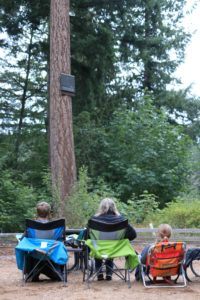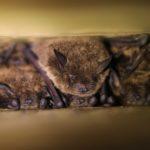You could see 500 bats – or you could see three.
Either way, every one of the 49 Northwest Trek staff, interns and volunteers that gathered for the twilight Bat Counts on June 28 and July 5 was vital. Armed with data sheets, click counters and plenty of comfy chairs, the bat counters were helping the wildlife park study its native population of bats – a study that in turn is crucial to helping scientists better understand and protect these tiny mammals.
Plus, it’s becoming a Trek tradition.
Bat Spotting

“Is that –?!”
“No, it’s a bird.”
I slumped back down onto the fleece blanket and resumed a kind of mesmerized staring at the bat box I’d been assigned to. It was 8:50pm, still 18 minutes short of sunset – the magical moment when bats prefer to dash out of their roosts to hunt for the night. But we’d been instructed to watch from half an hour beforehand, just in case, and there were only three of us responsible for counting this roost. So we waited. And waited.
The Great Trek Bat Count is actually two counts, over two nights in late June/July. Volunteers and staff gather near the park entrance while it’s still light to receive instructions and equipment: a pen, a sheet for recording data, and (if they need it) two clickers – one to count bats leaving the roost, and one to count those that may fly back inside. (The latter is subtracted from the former, to avoid a double-count.) Some folks opt for a phone app instead, and Zachary Hawn, conservation engagement coordinator at sister zoo Point Defiance Zoo & Aquarium, also brings an Echo Meter, a recording device plugged into a tablet to help ID bats from their echolocation clicks, which are inaudible to the human ear.
Forewarned, everyone also comes armed with camp chairs, cushions and fleeces, ready for up to two hours of bat-spotting.

“All right, everyone,” calls Rachael Mueller, Trek conservation engagement coordinator and the Bat Count leader. “There are several locations around the park where our bats like to roost, so I’ll be dividing you up between them. Are there any questions?”
“What if a bat lands on me?” asks Wesley, a nine-year-old who’s volunteering for the first time with mom Jennifer.
“Oh, they won’t,” reassures Rachael. “They just want to fly off and hunt.”
Wesley looks both disappointed and relieved.
Small groups start heading off for the veterinary clinic and tram barn, where bats love to roost in the eaves, while others disperse around the center of the park to watch the slim green custom-built bat boxes hanging around 25 feet up in the trees. The last group sets up camp right in front of the exit gates, where the largest bat colony has found a home in the roof space over the ticketing office.
Forest Bathing

Evening settles onto the forest. With no human noises to distract, I suddenly become acutely aware of birdsong, insect hums, the trickle of the stream. Swatting at the occasional mosquito, I stare at the green bat box as the light slowly fades from a golden summer sky. My breathing slows, as do my thoughts.
It’s a bit like forest meditation, only I can’t close my eyes – bats are swift and small, and I don’t want to miss them.
It’s 9:08pm – sunset. Nothing. A waft of summer scent washes over me, green and grassy, as if the forest is exhaling. I swat another mosquito, check my phone. The park’s gray wolves start howling, and it’s a little bizarre to realize that just a few hundred feet away from me there are two grizzly cubs falling asleep.
9:18pm. Nothing. The birds wind down their chorus.
Bat Action
 Then suddenly a tiny dark shape drops out of the box and flits away into the shadows, so fast I almost don’t believe my eyes. But next to me, my fellow counters are clicking, so I do too. Then there’s another bat, and a third. I sit up, eyes peeled, finger poised.
Then suddenly a tiny dark shape drops out of the box and flits away into the shadows, so fast I almost don’t believe my eyes. But next to me, my fellow counters are clicking, so I do too. Then there’s another bat, and a third. I sit up, eyes peeled, finger poised.
And then nothing. Ten more minutes of nothing. Mueller asked us to stop the count after five minutes of inactivity, so we pack up our chairs and wander quietly to the exit breezeway, where things are just a little different.
“95, 96, 97,” clicks the phone counter of the volunteer on the right side. The one on the left is ahead by 20. They stare at the entry points overhead with the intensity of soccer fans at a World Cup penalty shootout. Tiny bats are dropping and flitting in twos and threes, and when I peer up inside, the red night-light illuminates a whole colony of the little creatures, climbing around like miniature dragons, zooming back and forth and twittering to each other in high-pitched communication. It’s a window into another, Lilliputian world, and I feel enormous and somehow irrelevant, like Gulliver.
But by the end of the night, it’s clear that we humans are far from irrelevant to these astonishing animals who pollinate much of our food and eat the bugs that would otherwise invade us.
Colony Count

Overall, we’ve counted 455 bats: 270 from the exit, 74 at the tram barn, 53 at the vet clinic and 58 from all the bat boxes. The following week, a whopping 673 bats were counted, with 557 alone at the exit breezeway. Possible species include Yuma myotis, little brown myotis, California myotis, silver-haired and hoary bats, still to be confirmed from the Echo Meter recordings.
That’s a huge colony by Western Washington standards, one of the largest known in Pierce County. It’s also a healthy colony, having just been tested negative for any presence of the white-nose syndrome that has been wiping out bat colonies in eastern states.
Which is why our hours of waiting and counting are so vital – including my three bats. By learning more about how Northwest Trek bats live and thrive, scientists can better understand how to protect the entire species from threats like white-nose syndrome and loss of habitat.
Next time, though, I’m requesting a battier location.